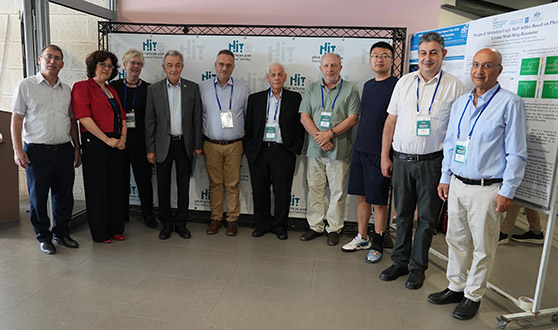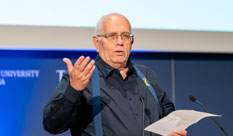More:
Events
HIT’s 6th Nanotechnology Conference from Academy to Industry
On Wednesday, June 14, a two-day conference of the Faculty of Electric and Electronics Engineering and the Faculty of Sciences started at HIT: "Nanotechnology: from Academy to Industry".

Photo: Doron Maserano
The 6th conference hosts meetings of industrialists and academics in the field of Nanotechnology.
"Nanotechnology: from Academy to Industry" is a conference that deals with nanotechnology and the latest innovations in the field. This conference brings together professionals from academia and industry to share common experiences in nanoscience research.
The conference is taking place again at HIT Holon Institute of Technology thanks to the assistance of the Ministry of Innovation, Science, and Technology.
Prof. Eduard Yakubov, President of HIT opened the conference and reviewed the academic activities in research and studies in the various faculties at HIT and proudly noted the dramatic increase in the number of academic study programs at the Institute, which has doubled since the Corona pandemic. In his speech, Prof. Yakubov mentioned the importance of the strong ties between the Institute and industry.
Dr. Refael Barkan HIT’s Vice President for Innovation, Entrepreneurship, and Internationalization, pointed out to the distinguished guests, that the conference is an opportunity to learn about the new developments in the world of nanotechnology, but also an opportunity for young researchers to present their projects and exchange ideas with the greatest experts in the field.
During the conference, 31 posters represented 31 ventures and projects in the field of nanotechnology by leading researchers were exhibited. "Knowledge of the electromechanical, thermal, and optoelectronic properties of nanomaterials, is of great importance when it comes to their integration into modern technologies. However, such properties are typically measured using instruments that do not have direct access to the material's atomic structure, defects, crystals, and space-resolved chemistry”, said Prof. Dmitry Golberg, School of Chemistry and Physics, Faculty of Science Queensland University of Technology, Brisbane, Australia. "In the presentation, I demonstrate the full usefulness of various state-of-the-art in situ and operando, transmission electron microscopy (TEM) techniques for property/function studies of frontier materials, e.g., individual carbon,1 boron nitride, and dichalcogenide nanotubes and nanosheets, inorganic nanowires, nanoparticles, and nanocomposites.
Prof. Alla Zak, Dean of the Faculty of Sciences, and co-organizer of the conference with Dr. Amos Bardea, Head of the undergraduate program at the Faculty of Electrical and Electronics Engineering, said that the field of nanomaterials, or nanotechnology, is a relatively young field in the world of science, and has only existed for about 20-30 years.
The latest studies show that known materials get new and special properties if they are synthesized in the form of crystals (nanoparticles) measuring a few nanometers or several tens of nanometers. These are optical properties, electronic properties, and mechanical properties and this has uses in the pharmaceutical world - accurate treatment of the problem with the help of a nanoparticle that 'transports' the medicine to the exact place (Drug Administration), for the needs of fast and accurate medical diagnosis, for various sensors, for strengthening materials for airplanes, vehicles, drones, and more".
Prof. Zak is also the Head of the Laboratory for the Synthesis and Research of Nanomaterials at HIT. In the laboratory, we will examine the use of these nanoparticles to store hydrogen that will replace gasoline, and oils/gases that provide renewable energy sources that will reduce the carbon dioxide greenhouse gas in the atmosphere.
The conference was attended by world-renowned researchers from Israel and abroad such as:
- Prof. Ron Naaman, Weizmann Institute of Science, Israel
- Prof. Dmitri Golberg, Queensland University of Technology, Australia
- Prof. Kenan Gundogdu, North Carolina State University, USA
- Prof. Janice L. Musfeldt, University of Tennessee, USA
- Prof. Daniel Nessim, Bar Ilan University, Israel
- Prof. Oded Shoseyov, Hebrew University of Jerusalem, Israel
- Prof. Boris Rybtchinski, Weizmann Institute of Science, Israel
- Prof. Ernesto Joselevich, Weizmann Institute of Science, Israel
- Prof. Shlomo Magdassi, Hebrew University of Jerusalem, Israel
- Prof. Andrei Manolescu, Reykjavik University, Iceland
- Prof. Yao Guo, Beijing Institute of Technology, China
- Dr. Ofer Cohen, Israel Institute for Biological Research (IIBR)
- Prof. Maya Bar-Sadan, Ben Gurion University, Israel
- Prof. Ester Segal, Technion, Israel
- Prof. Vladimir Osipov, HIT - Holon Institute of Technology, Israel
- Dr. Amir Handelman, HIT - Holon Institute of Technology, Israel
- Prof. Doron Naveh, Bar-Ilan University, Israel
- Dr. Noa Lachman, Tel Aviv University, Israel
- Dr. Doron Burshtain, SolarEdge Technologies Inc.
- Dr. Sébastien Gasc, Spacetek Technology AG, Switzerland
- Prof. Reshef Tenne, Weizmann Institute of Science, Member of HIT’s Academic Committee, Honorary Chair
- Prof. Alla Zak, HIT - Holon Institute of Technology, Chair
- Prof. Boris Fainberg, Prof. Alex Laikhtman, Dr. Amos Bardea, Dr. Amir Handelman, HIT - Holon Institute of Technology
- Dr. Avi Raveh, Ministry of Innovation, Science and Technology
Posted: 15/06/2023
- News & Events
New Collaboration with Sheba Medical Center will qualify nurses to work in a digital environment.
Collaboration between HIT Holon Institute of Technology, the teaching authority of the Sheba Medical Center, and the Sheba-BEYOND virtual hospital will allow training nurses in Israel and around the world to work in a digital...



 Additional programs
Additional programs
